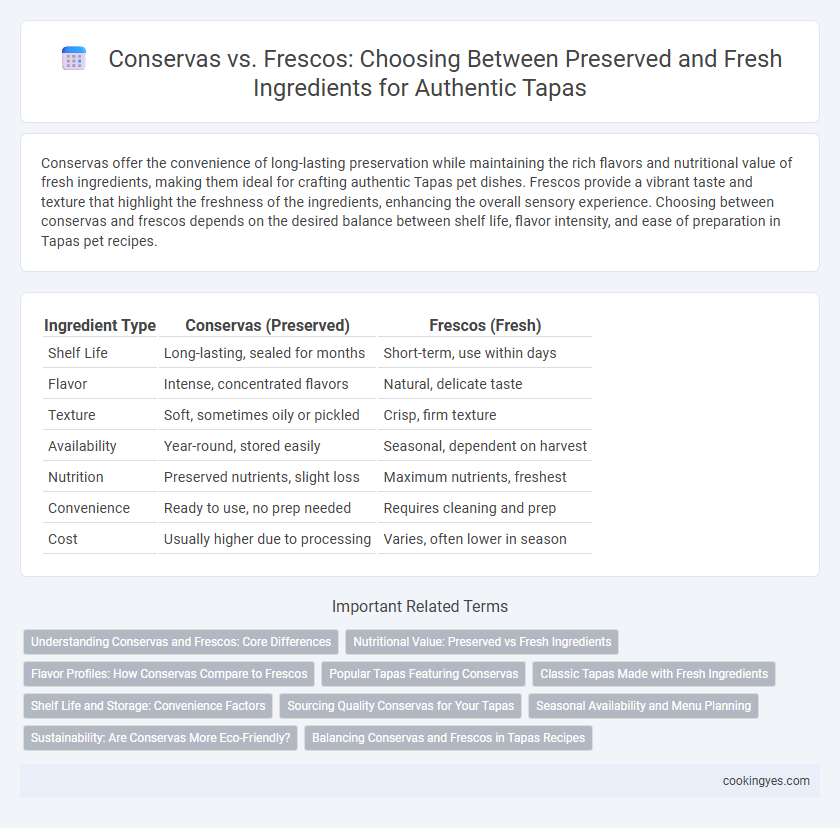Conservas offer the convenience of long-lasting preservation while maintaining the rich flavors and nutritional value of fresh ingredients, making them ideal for crafting authentic Tapas pet dishes. Frescos provide a vibrant taste and texture that highlight the freshness of the ingredients, enhancing the overall sensory experience. Choosing between conservas and frescos depends on the desired balance between shelf life, flavor intensity, and ease of preparation in Tapas pet recipes.
Table of Comparison
| Ingredient Type | Conservas (Preserved) | Frescos (Fresh) |
|---|---|---|
| Shelf Life | Long-lasting, sealed for months | Short-term, use within days |
| Flavor | Intense, concentrated flavors | Natural, delicate taste |
| Texture | Soft, sometimes oily or pickled | Crisp, firm texture |
| Availability | Year-round, stored easily | Seasonal, dependent on harvest |
| Nutrition | Preserved nutrients, slight loss | Maximum nutrients, freshest |
| Convenience | Ready to use, no prep needed | Requires cleaning and prep |
| Cost | Usually higher due to processing | Varies, often lower in season |
Understanding Conservas and Frescos: Core Differences
Conservas are preserved ingredients that undergo processes like canning, curing, or marinating to enhance shelf life while maintaining rich flavors, making them essential in traditional Spanish tapas. Frescos refer to fresh ingredients such as seafood, vegetables, and herbs used immediately for their natural taste and texture, contributing to vibrant and dynamic dishes. Understanding the balance between conservas and frescos allows chefs to combine longevity with freshness, creating diverse and authentic tapas experiences.
Nutritional Value: Preserved vs Fresh Ingredients
Preserved ingredients like conservas often retain essential nutrients such as vitamins and minerals due to careful canning processes that lock in freshness. Fresh ingredients typically offer higher levels of water-soluble vitamins like Vitamin C and delicate antioxidants, which can degrade during preservation. Comparing nutritional value, conservas provide a convenient source of long-lasting nutrients, while frescos deliver peak freshness and maximum nutrient density for tapas dishes.
Flavor Profiles: How Conservas Compare to Frescos
Conservas preserve intense, concentrated flavors by locking in freshness through traditional canning methods that enhance umami and depth, often amplifying the natural brininess or sweetness of ingredients like anchovies and octopus. Frescos offer vibrant, bright flavor profiles characterized by subtle nuances and delicate textures that reflect peak ripeness and freshness without alteration. Comparing the two, conservas provide a richer, more robust taste experience ideal for layering flavors in tapas, while frescos deliver a clean, crisp palate that highlights the freshness of seasonal produce.
Popular Tapas Featuring Conservas
Popular tapas featuring conservas highlight the rich flavors and convenience of preserved ingredients like anchovies, mussels, and octopus, sourced from traditional Spanish canneries known for their quality and authenticity. Compared to frescos, conservas provide a longer shelf life while maintaining intense taste profiles, enabling easy preparation of classic dishes such as boquerones en vinagre and mejillones al vapor. The balance of texture and umami in conservas complements fresh elements like olive oil, garlic, and herbs, creating iconic tapas that celebrate Spanish culinary heritage.
Classic Tapas Made with Fresh Ingredients
Classic tapas made with fresh ingredients highlight the vibrant flavors of seafood, vegetables, and herbs harvested at peak ripeness, ensuring a crisp texture and rich taste. Frescos emphasize the natural aroma and nutritional benefits, offering a more authentic and lively dining experience compared to conservas, which rely on preservation methods like curing, pickling, or canning. While conservas provide convenience and intensified flavors from aging, frescos remain the preferred choice for classic tapas due to their freshness and delicate balance of natural ingredients.
Shelf Life and Storage: Convenience Factors
Conservas, or preserved ingredients, offer extended shelf life ranging from months to years, making them ideal for long-term storage without refrigeration, which ensures consistent availability for tapas preparation. Frescos, or fresh ingredients, require immediate refrigeration and have a limited shelf life of a few days, demanding quick usage to maintain optimal flavor and texture. The convenience of conservas lies in their ready-to-use nature and reduced spoilage risk, while frescos provide superior freshness and vibrant taste but necessitate meticulous storage and timely consumption.
Sourcing Quality Conservas for Your Tapas
Sourcing quality conservas for your tapas involves selecting premium preserved ingredients like artisanal olives, anchovies, and octopus packed in olive oil or brine to ensure rich, authentic flavors. These preserved products offer consistent taste and extended shelf life, making them a reliable choice compared to fresh ingredients, which may vary in quality and availability. Emphasizing high-grade conservas elevates the overall tapas experience by delivering intense, concentrated flavors that complement fresh elements seamlessly.
Seasonal Availability and Menu Planning
Seasonal availability plays a crucial role in choosing between conservas and frescos for tapas menu planning. Conservas, or preserved ingredients like canned seafood and vegetables, offer a consistent supply regardless of season, ensuring menu stability and reduced ingredient waste. Frescos, or fresh ingredients, provide vibrant flavors and textures that highlight seasonal peaks but require careful sourcing to maintain quality and availability throughout varying harvest periods.
Sustainability: Are Conservas More Eco-Friendly?
Conservas, or canned preserved ingredients, offer greater sustainability compared to frescos due to extended shelf life reducing food waste and minimizing the carbon footprint associated with frequent transportation and refrigeration. The preservation process allows seasonal produce to be enjoyed year-round without relying on energy-intensive storage, while eco-friendly packaging innovations further enhance their green credentials. Choosing conservas supports resource efficiency and lowers environmental impact, making them a more eco-friendly option in tapas preparation.
Balancing Conservas and Frescos in Tapas Recipes
Balancing conservas and frescos in tapas recipes enhances both flavor and texture, combining the rich, concentrated taste of preserved ingredients such as anchovies, olives, and piquillo peppers with the bright, vibrant notes of fresh tomatoes, herbs, and seafood. Using conservas offers convenience and intense umami, while frescos provide crispness and freshness that invigorate each bite. Mastering the harmony between these elements results in authentic tapas with layered complexity and a satisfying contrast.
Conservas vs Frescos for preserved vs fresh ingredients Infographic

 cookingyes.com
cookingyes.com